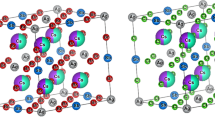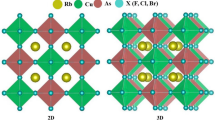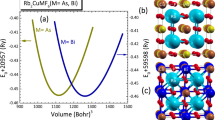Abstract—
The Bi12TiO20, Bi4Ti3O12, and Bi2Ti4O11 bismuth titanates have been prepared by solid-state reactions, via multistep firing of stoichiometric mixtures of their constituent oxides in air at temperatures from 1003 to 1273 K (Bi12TiO20, to 1123 K). The heat capacity of polycrystalline samples of the synthesized compounds has been determined by differential scanning calorimetry in the temperature range 330–1050 K. The Cp(T) curves of Bi4Ti3O12 and Bi2Ti4O11 show peaks at temperatures of 943 and 509 K, respectively, due to ferroelectric phase transitions. The experimental data have been used to evaluate the enthalpy increment, entropy change, and reduced Gibbs energy change of the bismuth titanates.




Similar content being viewed by others
REFERENCES
Speranskaya, E.I., Rez, I.S., Kozlova, L.V., et al., Bi2O3–TiO2 system, Izv. Akad. Nauk SSSR,Neorg. Mater., 1965, vol. 1, no. 2, pp. 232–235.
Kargin, Yu.F., Burkov, V.I., Mar’in, A.A., and Egorysheva, A.V., Kristally Bi12MxO20 ± δso strukturoi sillenita. Sintez, stroenie, svoistva (Sillenite-Structure Bi12MxO20 ± δ Crystals: Synthesis, Structure, and Properties), Moscow: Azbuka, 2004.
Hector, A.L. and Wiggin, S.B., Synthesis and structural study of stoichiometric Bi2Ti2O7 pyrochlore, J. Solid State Chem., 2004, vol. 177, pp. 139–145.https://doi.org/10.1016/S0022-4596(03)00378-5
Harjuija, J., Väyrynen, S., Putkonen, M., et al., Crystallization of bismuth titanate and bismuth silicate grown as thin films by atomic layer deposition, J. Cryst. Growth, 2006, vol. 286, pp. 376–383.https://doi.org/10.1016/j.jcrysgro.2005.10.020
Esquivel-Elizondo, R.J., Hinojosa, B.B., and Nino, J.C., Bi2Ti2O7: it is not what you have read, Chem. Mater., 2011, vol. 23, no. 22, pp. 4965–4974.https://doi.org/10.1021/cm202154c
Kahlenberg, V. and Böhm, H., Investigation of the α–β transition in Bi2Ti4O11, J. Phys.: Condens. Matter, 1994, vol. 6, pp. 6221–6228.
Lopez-Martinez, J., Romero-Serrano, A., Hernandez-Ramirez, A., et al., Thermal analysis and prediction of phase equilibria in the TiO2–Bi2O3 system, Thermochim. Acta, 2011, vol. 516, pp. 35–39.https://doi.org/10.1016/j.tca.2011.01.008
Kargin, Yu.F., Ivicheva, S.N., and Volkov, V.V., Phase relations in the Bi2O3–TiO2 system, Russ. J. Inorg. Chem., 2015, vol. 60, no. 5, pp. 619–625.https://doi.org/10.1134/S0036023615050083
Ivicheva, S.N., Kargin, Yu.F., Kutsev, S.V., and Ashmarin, A.A., Synthesis of different bismuth titanates and ordered Bi–Ti–O nanocomposites based on opal matrices, Russ. J. Inorg. Chem., 2015, vol. 60, no. 11, pp. 1439–1451.https://doi.org/10.1134/S003602361511008X
Mijazawa, S. and Tabata, T., Bi2O3–TiO2 binary phase diagram study for TSSG pulling of Bi12TiO20 single crystals, J. Cryst. Growth, 1998, vol. 191, pp. 512–516.
Skorikov, V.M., Kargin, Yu.F., Egorysheva, A.V., et al., Growth of sillenite-structure single crystals, Inorg. Mater., 2005, vol. 41, suppl. 1, pp. S24–S46.
Shulman, H.S., Testorf, M., Damjanovic, D., and Setter, N., Microstructure, electrical conductivity, and piezoelectric properties of bismuth titanate, J. Am. Ceram. Soc., 1996, vol. 79, no. 12, pp. 3124–3128.
Long, C., Chang, Q., and Fan, H., Differences in nature of electrical conductions among Bi4Ti3O12-based ferroelectric polycrystalline ceramics, Sci. Rep., 2017, pp. 1–15. www.nature.com/scientificreports. https://doi.org/10.1038/s41598-017-03266-y
Turner, C.G., Esquivel-Elizondo, J.R., and Nino, J.C., Dielectric properties and relaxation of Bi2Ti2O7, J. Am. Ceram. Soc., 2014, vol. 97, no. 6, pp. 1763–1768.https://doi.org/10.1111/jace.12803
Krasnov, A.G., Shein, I.R., and Piir, I.V., Experimental investigation and ab initio calculation of the properties of Sc-, In-doped bismuth titanates with the pyrochlore type structure, Phys. Solid State, 2017, vol. 59, no. 3, pp. 495–503.https://doi.org/10.1134/S1063783417030192
Hua, Z.-Z., Kimura, T., and Yamaguchi, T., Formation of Bi4Ti3O12 from Bi2O3–TiO2 mixtures, J. Ceram. Soc. Jpn., 1983, vol. 91, no. 9, pp. 420–423.
Tarabanov, G.A., Synthesis of Bi2O3-doped TiO2 ceramics, Inorg. Mater., 1992, vol. 28, no. 8, pp. 1792–1795.
Brutton, T.M., Study of the liquidus in the system Bi2O3–TiO2, J. Solid State Chem., 1974, vol. 9, no. 2, pp. 173–175.
Miyazawa, S., p-Doping growth of photorefractive Bi12TiO20 crystals, Opt. Mater., 1995, vol. 4, pp. 192–196.
Efendiev, Sh.M., Raman spectra in Bi12TiO20 single crystals, Phys. Status Solidi, 1984, vol. 123, pp. K105–K108.
Leonov, E.I., Semenov, A.E., and Shcherbakov, A.G., Joint analysis of vibrational spectra of Bi12SiO20, Bi12GeO20, and Bi12TiO20 crystals, Fiz. Tverdogo Tela (Leningrad), 1986, vol. 28, no. 5, pp. 1590–1593.
Skorikov, V.M., Zakharov, I.S., Volkov, V.V., and Spirin, E.A., Transmission and absorption spectra of Bi12GeO20, Bi12SiO20, and Bi12TiO20 single crystals, Inorg. Mater., 2002, vol. 38, no. 2, pp. 226–232.
Melot, B.C., Tackett, R., O’Brien, J., et al., Large low-temperature specific heat in pyrochlore Bi12TiO20, Phys. Rev. B: Condens. Matter Mater. Phys., 2009, vol. 79, paper 224111. https://doi.org/098-0121/2009/79(22)/224111(5)
Subramanian, M.A., Aravamudan, G., and Rao, G.V.S., Oxide pyrochlores—a review, Prog. Solid State Chem., 1983, vol. 15, pp. 55–143.
Radosavljevic, I., Evans, J.S.O., and Sleight, A.W., Synthesis and structure of pyrochlore-type bismuth titanate, J. Solid State Chem., 1998, vol. 136, pp. 63–66.
Hinojosa, B.B., Nino, J.C., and Asthagiri, A., Fist-principles study of cubic Bi pyrochlores, Phys. Rev. B: Condens. Matter Mater. Phys., 2008, vol. 77, paper 104123.https://doi.org/10.1103/PhysRevB.77.104123
Merka, O., Bahnemann, D.W., and Wark, M., Photocatalytic hydrogen production with non-stoichiometric pyrochlore bismuth titanate, Catal. Today, 2014, vol. 225, pp. 102–110.https://doi.org/10.1016/j.cattod.2013.09.009
Piir, I.V., Koroleva, M.S., Sekushin, N.A., et al., Synthesis, structure, and impedance spectra of iron-containing bismuth titanates, Russ. J. Electrochem., 2013, vol. 49, no. 8, pp. 817–821.https://doi.org/10.1134/S1023193513080168
Piir, I.V., Koroleva, M.S., Ryabkov, Yu.I., et al., Bismuth iron titanate pyrochlores: thermostability, structure, properties, J. Solid State Chem., 2013, vol. 204, pp. 245–250.https://doi.org/10.1016/j.jssc.2013.05.031
Koroleva, M.S., Piir, I.V., Ryabkov, Yu.I., et al., Synthesis and properties of chromium-containing bismuth titanate with the pyrochlore structure, Izv. Akad. Nauk, Ser. Khim., 2013, no. 2, pp. 410–413.
Kunej, Š., Škapin, S.D., and Suvorov, D., Phase relations in the pyrochlore-rich part of the Bi2O3–TiO2–Nd2O3 system, J. Am. Ceram. Soc., 2009, vol. 92, no. 10, pp. 2373–2377.https://doi.org/10.1111/j.1551-2916.2009.03207.x
Kunej, Š. and Suvorov, D., Dielectric properties of the Bi(1.6 – 0.8x)YxTi2O(6.4 – 0.3x) (0.03 < x < 2) pyrochlore solid solution, J. Am. Ceram. Soc., 2009, vol. 92, pp. 959–961.https://doi.org/10.1111/j.1551-2916.2009.02995.x
Li, F., Liu, X., Zhao, J., et al., Red-orange photoluminescence and dielectric relation of Eu3+-doped Bi2Ti2O7 pyrochlore structure thin films, Mater. Chem. Phys., 2015, vol. 162, pp. 801–806.https://doi.org/10.1016/j.matchemphys.2015.07.006
Mayfield, C.L. and Huda, M.N., Free energy landscape approach to aid pure phase synthesis of transition metal (X = Cr, Mn and Fe) doped bismuth titanate (Bi2Ti2O7), J. Cryst. Growth, 2016, vol. 444, pp. 46–54.https://doi.org/10.1016/j.jcrysgro.2016.03.038
Lelievre, J. and Marchet, P., Structure and properties of Bi2Ti2O7 pyrochlore type phase stabilized by lithium, J. Alloys Compd., 2018, vol. 732, pp. 178–186.https://doi.org/10.1016/j.jallcom.2017.10.128
Pelton, A.D. and Blander, M., Thermodynamic analysis of ordered liquid solutions by a modified quasichemical approach—application to silicate slags, Metall. Trans. B, 1986, vol. 17, pp. 805–815.
Suleimenova, G.S. and Skorikov, V.M., Thermochemical study of gamma bismuth oxide based single crystals, Thermochim. Acta, 1992, vol. 196, pp. 203–211.
Suleimenova, G.S. and Skorikov, V.M., Thermochemical studies of Bi4Ge3O12 and Bi4Ti3O12 single crystals, J. Therm. Anal., 1992, vol. 38, no. 5, pp. 1251–1256.
Shaskol’skaya, M.P., Kristallografiya (Crystallography), Moscow: Vysshaya Shkola, 1984.
Solovyov, L.A., Full-profile refinement by derivative difference minimization, J. Appl. Crystallogr., 2004, vol. 37, pp. 743–749.https://doi.org/10.1107/S0021889804015638
Tret’yakov, Yu.D., Tverdofaznye reaktsii (Solid-State Reactions), Moscow: Khimiya, 1978.
Denisova, L.T., Irtyugo, L.A., Kargin, Yu.F., et al., Synthesis and high-temperature heat capacity of Sm2Ge2O7 and Eu2Ge2O7, Inorg. Mater., 2018, vol. 54, no. 2, pp. 167–170. https://doi.org/10.1134/S0020168518020048
Denisov, V.M., Denisova, L.T., Irtyugo, L.A., and Biront, V.S., Thermal physical properties of Bi4Ge3O12 single crystals, Phys. Solid State, 2010, vol. 52, no. 7, pp. 1362–1365.https://doi.org/10.1134/S1063783410070073
Pineda-Flores, J.L., Chavira, E., Reyes-Gasga, J., et al., Synthesis and dielectric characteristics of the layered structure Bi4 – xRxTi3O12 (Rx = Pr, Nd, Gd, Dy), J. Eur. Ceram. Soc., 2003, vol. 23, pp. 839–850.
Hervoches, C.H. and Lightfoot, P., A variable-temperature powder neutron diffraction study of ferroelectric Bi4Ti3O12, Chem. Mater., 1999, vol. 11, pp. 3359–3364.
Lomanova, N.A., Tomkovich, M.V., Ugolkov, V.L., and Gusarov, V.V., Formation and Thermal Properties of Nanocrystalline Bi4Ti3O12, Russ. J. Appl. Chem., 2017, vol. 90, no. 6, pp. 831–837.
Akimov, A.I. and Savchuk, G.K., Synthesis and sintering of Bi2Ti4O11, Inorg. Mater., 2004, vol. 40, no. 7, pp. 716–720.https://doi.org/10.1023/B:INMA.0000034770.04111.12
Kidchob, T., Malfatti, L., Marongiu, D., et al., Sol–gel processing of Bi2Ti2O7 and Bi2Ti4O11 films with photocatalytic activity, J. Am. Ceram. Soc., 2010, vol. 93, no. 9, pp. 2897–2902.https://doi.org/10.1111/j.1551-2916.2010.03796.x
Zhang, Y., Zhang, Y., Fu, B., et al., Permittivity of citrate sol–gel derived Bi2Ti4O11 dielectric ceramics, Ceram. Int., 2015, vol. 41, pp. 10243–10249.https://doi.org/10.1016/j.ceramint.2015.04.137
Kahlenberg, V. and Böhm, H., Investigations of the α–β transition in Bi2Ti4O11, J. Phys.: Condens. Matter, 1994, vol. 6, pp. 6221–6228.
Samsonov, G.V., Borisova, A.L., Zhidkova, E.G., et al., Fiziko-khimicheskie svoistva okislov. Spravochnik (Physicochemical Properties of Oxides: A Handbook), Moscow: Metallurgiya, 1978.
Vonsovskii, S.V., Magnetizm (Magnetism), Moscow: Nauka, 1971.
Potashinskii, A.Z. and Pokrovskii, V.L., Fluktuatsionnaya teoriya fazovykh perekhodov (Fluctuation Theory of Phase Transitions), Moscow: Nauka, 1982.
Gusev, A.I., Nestekhiometriya, besporyadok, blizhnii i dal’nii poryadok v tverdom tele (Nonstoichiometry, Disorder, and Short- and Long-Range Order in Solids), Moscow: Fizmatlit, 2007.
Strukov, B.A. and Levanyuk, A.P., Fizicheskie osnovy segnetoelektricheskikh yavlenii v kristallakh (Physical Principles of Ferroelectricity in Crystals), Moscow: Fizmatlit, 1983.
Maier, C.G. and Kelley, K.K., An equation for the representation of high temperature heat content data, J. Am. Chem. Soc., 1932, vol. 54, no. 8, pp. 3243–3246.
Denisov, V.M., Denisova, L.T., Irtyugo, L.A., et al., High-temperature heat capacity of BaFe12O19 and BaSc0.5Fe11.5O19, Phys. Solid State, 2013, vol. 55, no. 1, S. 240–242.https://doi.org/10.1134/S1063783412120116
Bush, A.A. and Popova, E.A., Heat capacity of the Pb5(Ge1 – xSix)3O11 ferroelectric system, Phys. Solid State, 2004, vol. 46, no. 5, pp. 902–907.https://doi.org/10.1134/1.1744969
Denisova, L.T., Chumilina, L.G., Belousova, N.V., et al., High-temperature heat capacity of CdO–V2O5 oxides, Phys. Solid State, 2017, vol. 59, no. 12, pp. 2519–2523. https://doi.org/1134/S1063783417120344
Leitner, J., Chuchvalec, P., Sedmidubcký, D., et al., Estimation of heat capacities of solid mixed oxides, Thermochim. Acta, 2003, vol. 395, pp. 27–46.
Author information
Authors and Affiliations
Corresponding author
Additional information
Translated by O. Tsarev
Rights and permissions
About this article
Cite this article
Denisova, L.T., Kargin, Y.F., Chumilina, L.G. et al. Heat Capacity of Compounds in the Bi2O3–TiO2 System. Inorg Mater 56, 597–604 (2020). https://doi.org/10.1134/S0020168520060047
Received:
Revised:
Accepted:
Published:
Issue Date:
DOI: https://doi.org/10.1134/S0020168520060047




